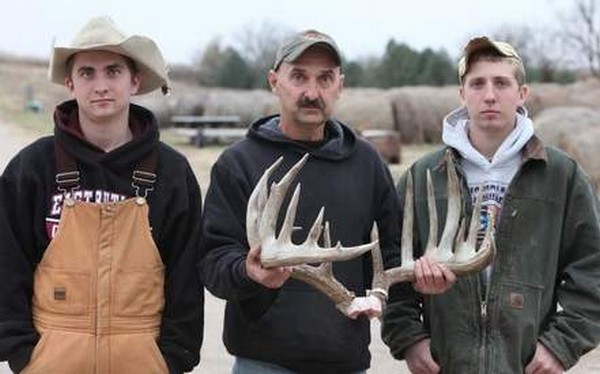The state of Nebraska is known for some big-bodied, big-antler bucks, but nobody, not even deer hunter Kevin Petrzilka, was expecting to bag a potential Nebraska state buck just outside of the town of Loma in Butler County, Nebraska. However, that’s exactly what he did on his last hunt.
And if the measurements hold up the big buck looks to rank at least number 6 on the Boone and Crockett Club’s all-time list of whitetails with typical antlers taken by a firearm. To say this 17 point whitetail buck is big would be a serious understatement of an animal of remarkable proportions.

In fact, the Petrzilka buck is sizing up to be the largest buck taken by firearm in North America since 1993! An official Boone and Crockett Club scorer put the preliminary score at 203 4/8 inches over the weekend, but the antlers must go through the mandatory 60 day drying period before they can be officially scored for the record book. For those keeping score, the current Nebraska record for a typical whitetail buck is 199 1/4 inches on a buck taken in 1983 in Saunders County.
Deer antlers usually shrink when hunters walk up on their kill. However, that didn’t happen to Petrzilka. The inside antler spread on Petrzilka’s deer was 21 inches and the heavy mass followed the tines from the base all the way out to the ends of the beams. The antlers have eight points on one side of the rack and nine on the other. “My boy got there first and all I heard him say was, ‘Big! Big! Big!” Petrzilka said. The local taxidermist had this to say about the antlers of this potential Nebraska state record typical buck:
“If the buck stays as a typical, because there is a concern that his G3’s may count as non-typical, he will rank near the top in the world. No matter what happens with this buck as far as scores go, he is a once in a lifetime trophy and will be in a few magazines, no doubt. I have physically seen a couple bigger non-typical deer in person, but this is the biggest typical by far.
Milo Hanson’s world record typical buck is 213 inches just to put into perspective, and Nebraska’s #1 typical is 199 inches. Time will tell, but I had to share because talk of a Nebraska state record buck is all the buzz in this part of the state.”
Mr. Petrzilka said he knew the buck was big, but did not take time to notice the buck’s rack before he fired at the deer, which at the time was 150 yards away and on a dead run. “It was there, I shot and it was over with,” he said. “I sort of wish I’d missed and Dillon got it, but it worked out.” I’d say so. A Nebraska state record buck is nothing to snort at.




In keeping with the story ie. size of deer, Nebraska, Kansas, Iowa ect have larger body deer. How many sub-species of deer do we find in Texas? This question comes up because I see larger bodied deer in the panhandle vs. south or even central texas. Both regions have the potential to grow large animals and large racks under regular conditions based on nutrition.
Thanks
Now that’s the buck I’d like to bag! WOW!
All animals get larger (body-wise) the farther north you go.
That is a massive set of antlers. I do agree that there should be some concern that the left G3 seems to split and may count as a non-typical point. Looks to be the same case with the G4, or G5 if the G3 doesn’t count as a split. It would definitely count against the net score of a typical. I’m not a fan of net scoring anyways. What does “symmetry” really matter? My opinion is just appreciate the animal for every inch of antler it gives, not a made-up deduction scheme. That buck is a truly magnificent animal.
No offense, but that is a true bunch of rednecks. I’m from Nebraska too and absolutely love the people.
My guess is that it will not hold up as a typical. There was a huge whitetail killed in one of the Canadian provinces several years ago by a man named Wayne Zaft (bow kill)That deer was first scored as typical in the low 200’s but after review got knocked down to the low 180’s because of the same thing mentioned here, about the common bases of the G2 & 3. He was really mad about it and refused to enter the deer in any record books.